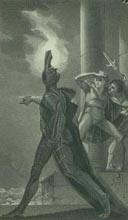
Giving up the Ghost: Ways of Seeing the Ghost in Hamlet
By
Janet Field-Pickering
Folger
Shakespeare Library
Washington, DC
 |
Introduction: This lesson uses images of artwork and clips of a theatrical performance and a silent film to help students think about various ways to interpret the character of the Ghost in Hamlet. It can be also used as a continuation of a previous elementary level lesson, Hamlet: Word Pictures and Ghost Stories. |
Goals: To explore different ways of viewing and interpreting character through artwork, performance, and film; to listen and contribute to ideas in class discussions; to analyze how the visual, nonverbal components of performance and film contribute to an interpretation and understanding of character.
Skills: critical viewing of artwork, performance and film; collaborative learning; making inferences
How long: 1-2 class periods
Suggested grade level: 4-6
Lesson-Part 1
|
Angels
and ministers of grace, defend us!
Be thou a spirit or goblin damned, Bring with thee airs from heaven or blasts from hell Be thy intents wicked or charitable Thou com'st in such a questionable shape That I will speak to thee. O answer me! Let me not burst in ignorance, but tell Why thy canonized bones, hearsed in death, Have burst their cerements; why the sepulcher, Wherein we saw thee quietly interred, Hath oped his ponderous and marble jaws To cast thee up again. What may this mean That thou, dead corse, again in complete steel, Revisits thus the glimpses of the moon, Making night hideous, and we fools of nature So horridly to shake our disposition (Hamlet 1.4.43-62, cut) |
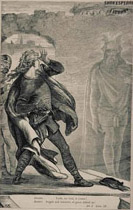 |
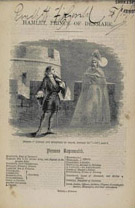 |
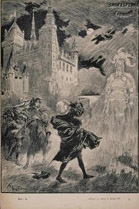 |
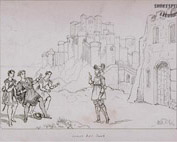 |
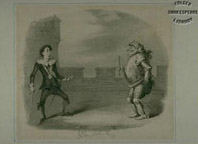 |
If your students completed the activities of the lesson, Hamlet: Word Pictures and Ghost Stories, and created their own drawings, compare the artists' work with the children's drawings by asking the following questions:
Lesson-Part 2
1. Look at the clip of the Georgia Shakespeare Festival's production of Hamlet, where the Ghost first starts speaking to Hamlet.
GEORGIA FESTIVAL PRODUCTION OF HAMLET (1999)
Mute the volume of the scene so that your students can't hear the dialogue.
2. Discuss the actor's interpretation of the Ghost. Concentrate on what you see.
3. Look at the actor who plays Hamlet. Again concentrate on what you see.
4. After discussing the clip, play it again and see if the students notice anything else about the clip. Then ask them to select their favorite image from the Art Archive and compare or contrast the actor's vision of the Ghost with the artist's vision of the Ghost.
Extending the lesson:
Show your student a clip of the same scene from the 1913 Forbes-Robertson black and white silent film, and discuss, using the same questions as above.
FORBES-ROBERTSON PRODUCTION OF HAMLET (1913)
Links: